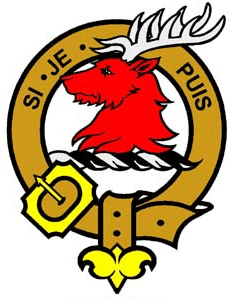Colquhoun Clan
Colquhoun Clan Crest: A stags head.
Colquhoun Clan Motto: Si Je Puis (If I can).
Colquhoun Clan History:
This is a territorial name taken from the barony of Colquhoun on the shores of Loch Lomond in Dunbartonshire. In the reign of Alexander II, Humphrey de Kilpatrick or Kirkpatrick obtained a grant of the lands of Auchentorily, Colquhoun and Dumbuck, from Malduin, Earl of Lennox, and built Dunglas Castle overlooking the River Clyde.
The lands of Luss came into the family in the 14th century when Sir Robert of Colquhoun married 'The Fair Maid of Luss,' descendant of Maldwin, Dean of the Lennox. Sir John Colquhoun of Luss was appointed Governor of Dumbarton Castle in the reign of James II, but was killed during a raid on the island of Inchmurrin in 1439. His son, also Sir John, rose to become Comptroller of the Royal Household and in 1457 received a Charter which incorporated all of the Colquhoun lands into a free barony, which later included the forest of Rossdhu and the lands of Kilmardinny. Sir John was killed by a canonball at the siege of Dunbar Castle.
Clan Gregor attacked Luss in 1603 with great ferocity. Alexander Colquhoun, 17th of Luss, was granted a Royal Commission to retaliate and, at the Battle of Glenfruin, known as the 'Glen of Sorrow,' over 200 Colquhouns were killed. As a consequence, Clan Gregor was outlawed and the MacGregor Chief eventually caught and hanged with eleven of his principal clansmen. Hatred between the two clans nevertheless continued unabated until the 18th century when the Chiefs of Colquhoun and MacGregor met at Glenfruin to shake hands and call a truce.
Sir John Colquhoun, 19th of Luss, one of the first baronets of Nova Scotia, is said to have openly engaged in sorcery. He married Lady Lilias Graham, a sister of the 1st Marquis of Montrose, and subsequently absconded with another sister, Lady Catherine Graham. Charges were brought against him and his estates confiscated, although they were later returned to his eldest son in 1646.
Sir John, 2nd Baronet of Luss, married Margaret, daughter and sole heiress of Sir Gideon Baillie of Lochend, in the county of Haddington. Sir Humphrey, 5th baronet, was a member of the last Scottish Parliament, and strenuously
opposed the Treaty of Union in 1707. He died in 1718, and, by special dispensation, was succeeded in his estate and honours by James Grant of Pluscardine, his son-in-law, under the name and designation of Sir James
Colquhoun of Luss.
Sir Iain Colquhoun, 31st of Luss, was Grand Master Mason of Scotland and elected Lord Rector of Glasgow University. In 1964, Iona Colquhoun, daughter of Sir Ivar Colquhoun of Luss, 32nd Chief of Colquhoun, married
the Marquis of Lorne, later 12th Duke of Argyll.
James Caldwell Calhoun (1782-1850) was Vice President of the United States of America. A Lieutenant Jimmy Calhoun of the 7th US Cavalry took part in Custer's Last Stand and died at the Battle of the Little Big Horn in 1876. Archibald Colquhoun (1848-1914) was the first administrator of Mashonaland. Robert Colquhoun (1914-62), born in Kilmarnock, was a prominent Scottish artist.
Places of Interest:
Dumbarton Castle, Dumbarton. Sir John Colquhoun of Luss was Governor under James II.
Glenfruin, Dunbartonshire. Scene of Colquhoun massacre by Clan Macgregorin 1603.
Inchmurrin Castle, Inchmurrin, Loch Lomond. The ruins of the island castle where Sir John Colquhoun was murdered with his attendants in 1439
Rossdhu House, Luss, on east shore of Loch Lomond. This now forms the club house of the exclusive Loch Lomond Golf Club. The ruins of the mediaeval Rossdhu Castle stand on a rise close to the club house.
Associated family names (Septs): Calhoun, Cowan, Cowen, Ingram, Kilpatrick, Kirkpatrick, Laing, MacAchounich, MacClintock, MacCowan, MacLinden, MacLintock, MacMains, MacManus, Macowan.
Surname distribution in Scotland: The Colquhoun surname is most commonly found in Glasgow, Dunbartonshire, Renfrewshire and Argyll and Bute.

